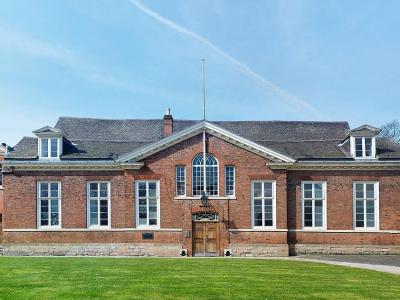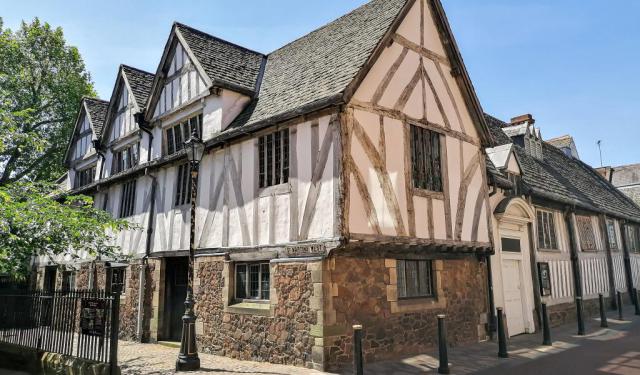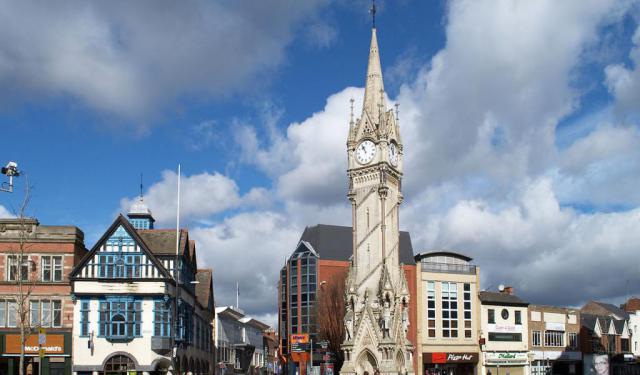
Leicester Castle and Castle Gardens, Leicester
Leicester Castle, a historic stronghold in the heart of Leicester, stands as a reminder of the city's medieval past. Located west of the city center, between Saint Nicholas Circle and De Montfort University, the castle complex features a large motte, the Great Hall, the ruined Turret Gateway, and the Church of Saint Mary de Castro. Once a formidable defensive structure, the castle was built around 1070, shortly after the Norman Conquest, incorporating parts of the old Roman town walls.
For centuries, Leicester Castle was home to the Earls of Leicester, passing from the House of Beaumont to Montfort and later Lancaster. It briefly served as a royal residence under Henry IV to Edward IV but declined by the 15th century, with the Great Hall becoming a courthouse. In 1426, it hosted the Parliament of Bats, where attendees carried clubs instead of swords due to a weapons ban.
Leicester Castle faced conflict during the 1173 rebellion, when Leicester was besieged and burned, and again in the 1640s Civil War, with gun loops added for defense. Now a scheduled monument, its Great Hall features an 18th-century Queen Anne-style façade.
Adjacent to the castle lies Castle Gardens, a peaceful green space by the Grand Union Canal. Situated in the former medieval city, this tranquil park offers visitors a chance to explore Leicester’s rich heritage while enjoying nature. The motte, accessible via footpaths and steps, provides panoramic views, while the cobbled paths lead visitors toward the Turret Gateway and Saint Mary de Castro Church, which once hosted the wedding of Geoffrey Chaucer and the knighting of the young Henry VI.
Castle Gardens is a haven of biodiversity within the city. Its well-maintained flowerbeds, mature trees, and natural vegetation support pollinating insects, while the ornamental pond provides a habitat for frogs and smooth newts. The surrounding historic buildings and nearby waterways also make the area an ideal roosting and foraging site for bats. Whether strolling through its seasonal plantings or resting on a bench overlooking the canal, visitors to Castle Gardens can enjoy a serene retreat within Leicester’s historic core.
For centuries, Leicester Castle was home to the Earls of Leicester, passing from the House of Beaumont to Montfort and later Lancaster. It briefly served as a royal residence under Henry IV to Edward IV but declined by the 15th century, with the Great Hall becoming a courthouse. In 1426, it hosted the Parliament of Bats, where attendees carried clubs instead of swords due to a weapons ban.
Leicester Castle faced conflict during the 1173 rebellion, when Leicester was besieged and burned, and again in the 1640s Civil War, with gun loops added for defense. Now a scheduled monument, its Great Hall features an 18th-century Queen Anne-style façade.
Adjacent to the castle lies Castle Gardens, a peaceful green space by the Grand Union Canal. Situated in the former medieval city, this tranquil park offers visitors a chance to explore Leicester’s rich heritage while enjoying nature. The motte, accessible via footpaths and steps, provides panoramic views, while the cobbled paths lead visitors toward the Turret Gateway and Saint Mary de Castro Church, which once hosted the wedding of Geoffrey Chaucer and the knighting of the young Henry VI.
Castle Gardens is a haven of biodiversity within the city. Its well-maintained flowerbeds, mature trees, and natural vegetation support pollinating insects, while the ornamental pond provides a habitat for frogs and smooth newts. The surrounding historic buildings and nearby waterways also make the area an ideal roosting and foraging site for bats. Whether strolling through its seasonal plantings or resting on a bench overlooking the canal, visitors to Castle Gardens can enjoy a serene retreat within Leicester’s historic core.
Want to visit this sight? Check out these Self-Guided Walking Tours in Leicester. Alternatively, you can download the mobile app "GPSmyCity: Walks in 1K+ Cities" from Apple App Store or Google Play Store. The app turns your mobile device to a personal tour guide and it works offline, so no data plan is needed when traveling abroad.
Leicester Castle and Castle Gardens on Map
Sight Name: Leicester Castle and Castle Gardens
Sight Location: Leicester, England (See walking tours in Leicester)
Sight Type: Attraction/Landmark
Guide(s) Containing This Sight:
Sight Location: Leicester, England (See walking tours in Leicester)
Sight Type: Attraction/Landmark
Guide(s) Containing This Sight:
Walking Tours in Leicester, England
Create Your Own Walk in Leicester
Creating your own self-guided walk in Leicester is easy and fun. Choose the city attractions that you want to see and a walk route map will be created just for you. You can even set your hotel as the start point of the walk.
Historical Buildings
Leicester, a city in England's East Midlands, has a storied past that is vividly presented in its historical buildings. Valuable architectural monuments, they are the city's pride and as such enjoy special protection by the government.
Among such, Magazine Gateway stands as a testament to the city's medieval legacy. Originally part of its defensive walls, this structure now... view more
Tour Duration: 2 Hour(s)
Travel Distance: 2.6 Km or 1.6 Miles
Among such, Magazine Gateway stands as a testament to the city's medieval legacy. Originally part of its defensive walls, this structure now... view more
Tour Duration: 2 Hour(s)
Travel Distance: 2.6 Km or 1.6 Miles
Leicester Introduction Walking Tour
Leicester is one of the oldest cities in England, whose history goes back almost two millennia. The Romans arrived in the area around 47 AD, during their conquest of southern Britain. Following the Saxon invasion, Leicester was then captured by Danish Vikings, in the 9th century.
The settlement was first documented in the early 10th century, under the name Ligeraceaster. At the time of the... view more
Tour Duration: 1 Hour(s)
Travel Distance: 1.1 Km or 0.7 Miles
The settlement was first documented in the early 10th century, under the name Ligeraceaster. At the time of the... view more
Tour Duration: 1 Hour(s)
Travel Distance: 1.1 Km or 0.7 Miles


